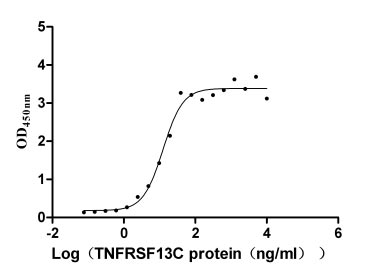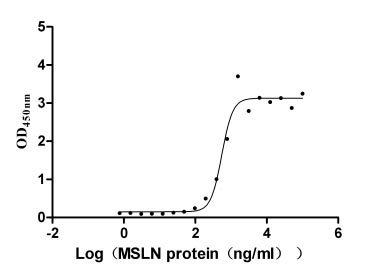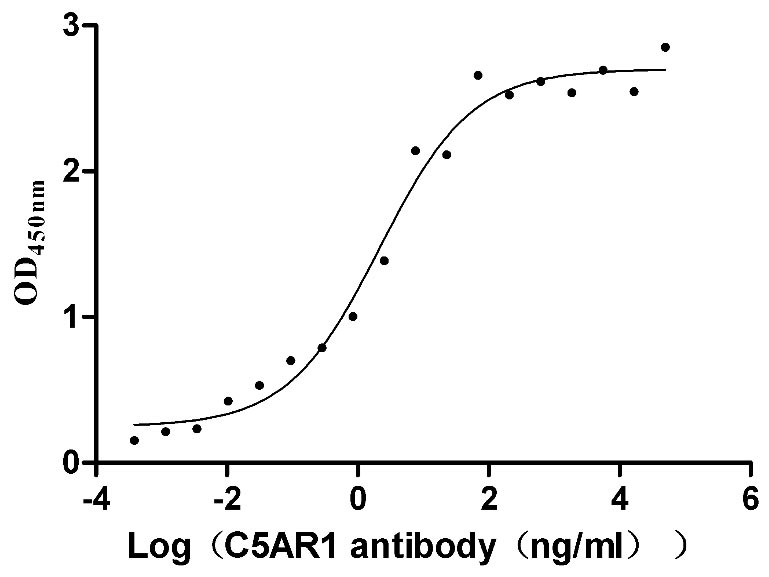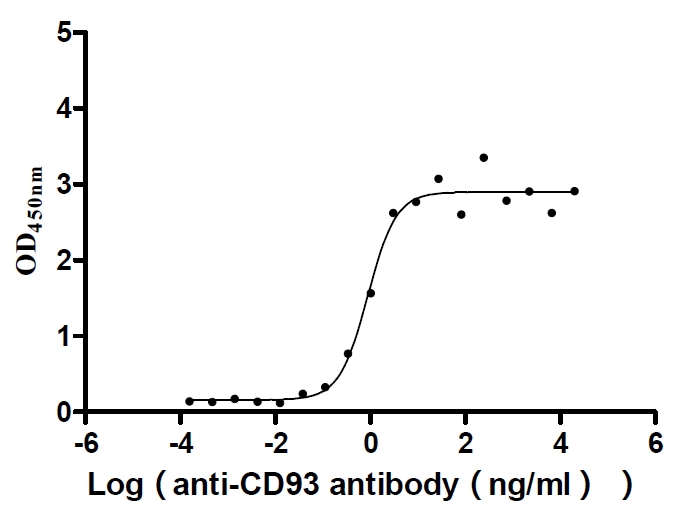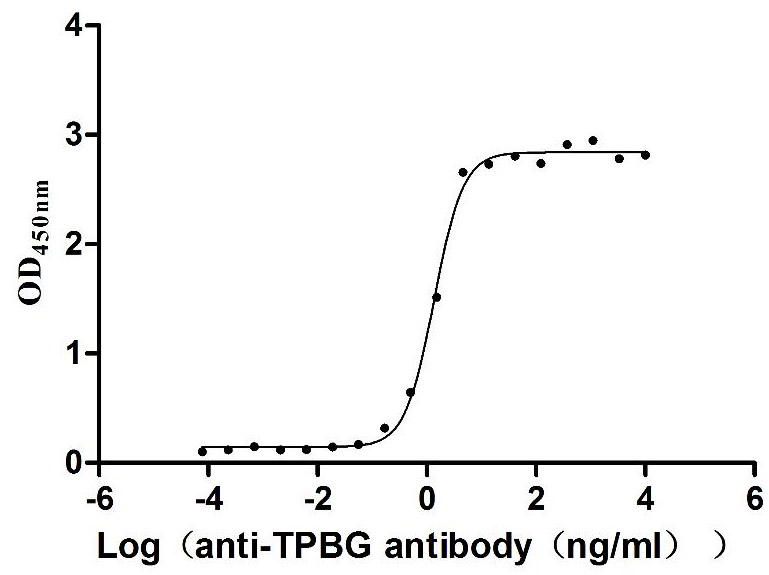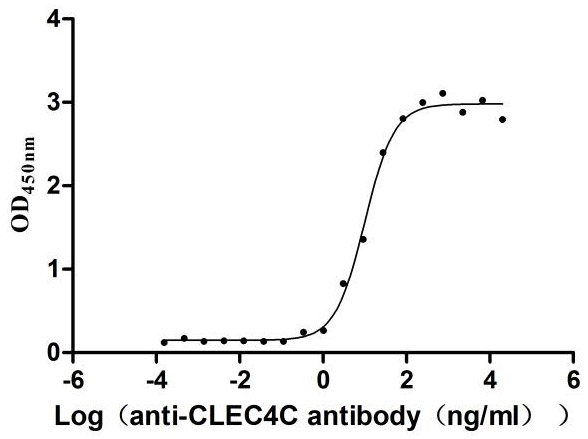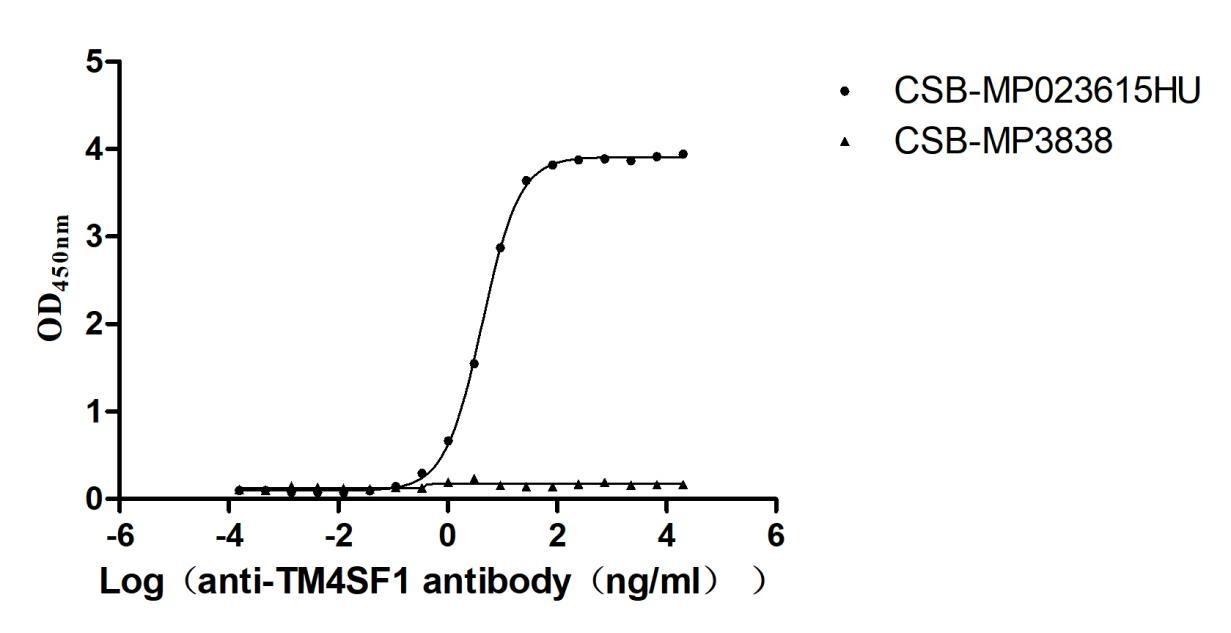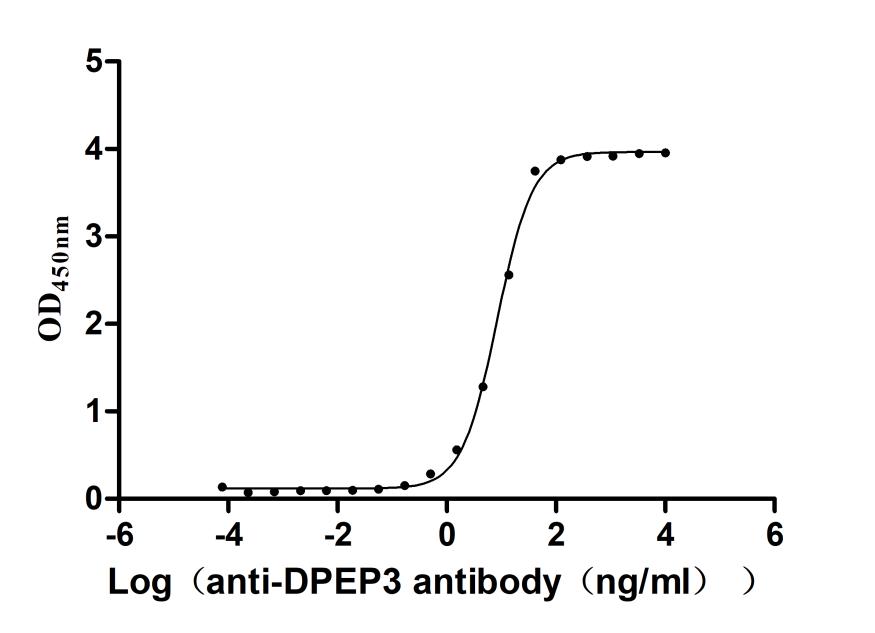Recombinant Mouse Nuclear receptor subfamily 1 group D member 1 (Nr1d1)
-
中文名称:小鼠Nr1d1重组蛋白
-
货号:CSB-YP664969MO
-
规格:
-
来源:Yeast
-
其他:
-
中文名称:小鼠Nr1d1重组蛋白
-
货号:CSB-EP664969MO
-
规格:
-
来源:E.coli
-
其他:
-
中文名称:小鼠Nr1d1重组蛋白
-
货号:CSB-EP664969MO-B
-
规格:
-
来源:E.coli
-
共轭:Avi-tag Biotinylated
E. coli biotin ligase (BirA) is highly specific in covalently attaching biotin to the 15 amino acid AviTag peptide. This recombinant protein was biotinylated in vivo by AviTag-BirA technology, which method is BriA catalyzes amide linkage between the biotin and the specific lysine of the AviTag.
-
其他:
-
中文名称:小鼠Nr1d1重组蛋白
-
货号:CSB-BP664969MO
-
规格:
-
来源:Baculovirus
-
其他:
-
中文名称:小鼠Nr1d1重组蛋白
-
货号:CSB-MP664969MO
-
规格:
-
来源:Mammalian cell
-
其他:
产品详情
-
纯度:>85% (SDS-PAGE)
-
基因名:Nr1d1
-
Uniprot No.:
-
别名:Nr1d1; Ear1; Nuclear receptor subfamily 1 group D member 1; Rev-erbA-alpha; V-erbA-related protein 1; EAR-1
-
种属:Mus musculus (Mouse)
-
蛋白长度:full length protein
-
表达区域:1-615
-
氨基酸序列MTTLDSNNNT GGVITYIGSS GSSPSRTSPE SLYSDSSNGS FQSLTQGCPT YFPPSPTGSL TQDPARSFGS APPSLSDDSS PSSASSSSSS SSSSFYNGSP PGSLQVAMED SSRVSPSKGT SNITKLNGMV LLCKVCGDVA SGFHYGVHAC EGCKGFFRRS IQQNIQYKRC LKNENCSIVR INRNRCQQCR FKKCLSVGMS RDAVRFGRIP KREKQRMLAE MQSAMNLANN QLSSLCPLET SPTPHPTSGS MGPSPPPAPA PTPLVGFSQF PQQLTPPRSP SPEPTMEDVI SQVARAHREI FTYAHDKLGT SPGNFNANHA SGSPSATTPH RWESQGCPSA PNDNNLLAAQ RHNEALNGLR QGPSSYPPTW PSGPTHHSCH QPNSNGHRLC PTHVYSAPEG EAPANSLRQG NTKNVLLACP MNMYPHGRSG RTVQEIWEDF SMSFTPAVRE VVEFAKHIPG FRDLSQHDQV TLLKAGTFEV LMVRFASLFN VKDQTVMFLS RTTYSLQELG AMGMGDLLNA MFDFSEKLNS LALTEEELGL FTAVVLVSAD RSGMENSASV EQLQETLLRA LRALVLKNRP SETSRFTKLL LKLPDLRTLN NMHSEKLLSF RVDAQ
-
蛋白标签:Tag type will be determined during the manufacturing process.
The tag type will be determined during production process. If you have specified tag type, please tell us and we will develop the specified tag preferentially. -
产品提供形式:Lyophilized powder
Note: We will preferentially ship the format that we have in stock, however, if you have any special requirement for the format, please remark your requirement when placing the order, we will prepare according to your demand. -
复溶:We recommend that this vial be briefly centrifuged prior to opening to bring the contents to the bottom. Please reconstitute protein in deionized sterile water to a concentration of 0.1-1.0 mg/mL.We recommend to add 5-50% of glycerol (final concentration) and aliquot for long-term storage at -20℃/-80℃. Our default final concentration of glycerol is 50%. Customers could use it as reference.
-
储存条件:Store at -20°C/-80°C upon receipt, aliquoting is necessary for mutiple use. Avoid repeated freeze-thaw cycles.
-
保质期:The shelf life is related to many factors, storage state, buffer ingredients, storage temperature and the stability of the protein itself.
Generally, the shelf life of liquid form is 6 months at -20°C/-80°C. The shelf life of lyophilized form is 12 months at -20°C/-80°C. -
货期:Delivery time may differ from different purchasing way or location, please kindly consult your local distributors for specific delivery time.Note: All of our proteins are default shipped with normal blue ice packs, if you request to ship with dry ice, please communicate with us in advance and extra fees will be charged.
-
注意事项:Repeated freezing and thawing is not recommended. Store working aliquots at 4°C for up to one week.
-
Datasheet :Please contact us to get it.
靶点详情
-
功能:Transcriptional repressor which coordinates circadian rhythm and metabolic pathways in a heme-dependent manner. Integral component of the complex transcription machinery that governs circadian rhythmicity and forms a critical negative limb of the circadian clock by directly repressing the expression of core clock components ARTNL/BMAL1, CLOCK and CRY1. Also regulates genes involved in metabolic functions, including lipid and bile acid metabolism, adipogenesis, gluconeogenesis and the macrophage inflammatory response. Acts as a receptor for heme which stimulates its interaction with the NCOR1/HDAC3 corepressor complex, enhancing transcriptional repression. Recognizes two classes of DNA response elements within the promoter of its target genes and can bind to DNA as either monomers or homodimers, depending on the nature of the response element. Binds as a monomer to a response element composed of the consensus half-site motif 5'-[A/G]GGTCA-3' preceded by an A/T-rich 5' sequence (RevRE), or as a homodimer to a direct repeat of the core motif spaced by two nucleotides (RevDR-2). Acts as a potent competitive repressor of ROR alpha (RORA) function and regulates the levels of its ligand heme by repressing the expression of PPARGC1A, a potent inducer of heme synthesis. Regulates lipid metabolism by repressing the expression of APOC3 and by influencing the activity of sterol response element binding proteins (SREBPs); represses INSIG2 which interferes with the proteolytic activation of SREBPs which in turn govern the rhythmic expression of enzymes with key functions in sterol and fatty acid synthesis. Regulates gluconeogenesis via repression of G6PC1 and PEPCK and adipocyte differentiation via repression of PPARG. Regulates glucagon release in pancreatic alpha-cells via the AMPK-NAMPT-SIRT1 pathway and the proliferation, glucose-induced insulin secretion and expression of key lipogenic genes in pancreatic-beta cells. Positively regulates bile acid synthesis by increasing hepatic expression of CYP7A1 via repression of NR0B2 and NFIL3 which are negative regulators of CYP7A1. Modulates skeletal muscle oxidative capacity by regulating mitochondrial biogenesis and autophagy; controls mitochondrial biogenesis and respiration by interfering with the STK11-PRKAA1/2-SIRT1-PPARGC1A signaling pathway. Represses the expression of SERPINE1/PAI1, an important modulator of cardiovascular disease and the expression of inflammatory cytokines and chemokines in macrophages. Represses gene expression at a distance in macrophages by inhibiting the transcription of enhancer-derived RNAs (eRNAs). Plays a role in the circadian regulation of body temperature and negatively regulates thermogenic transcriptional programs in brown adipose tissue (BAT); imposes a circadian oscillation in BAT activity, increasing body temperature when awake and depressing thermogenesis during sleep. In concert with NR2E3, regulates transcriptional networks critical for photoreceptor development and function. In addition to its activity as a repressor, can also act as a transcriptional activator. In the ovarian granulosa cells acts as a transcriptional activator of STAR which plays a role in steroid biosynthesis. In collaboration with SP1, activates GJA1 transcription in a heme-independent manner. Represses the transcription of CYP2B10, CYP4A10 and CYP4A14. Represses the transcription of CES2. Represses and regulates the circadian expression of TSHB in a NCOR1-dependent manner. Negatively regulates the protein stability of NR3C1 and influences the time-dependent subcellular distribution of NR3C1, thereby affecting its transcriptional regulatory activity. Plays a critical role in the circadian control of neutrophilic inflammation in the lung; under resting, non-stress conditions, acts as a rhythmic repressor to limit inflammatory activity whereas in the presence of inflammatory triggers undergoes ubiquitin-mediated degradation thereby relieving inhibition of the inflammatory response. Plays a key role in the circadian regulation of microglial activation and neuroinflammation; suppresses microglial activation through the NF-kappaB pathway in the central nervous system. Plays a role in the regulation of the diurnal rhythms of lipid and protein metabolism in the skeletal muscle via transcriptional repression of genes controlling lipid and amino acid metabolism in the muscle.
-
基因功能参考文献:
- Taken together, Nr1d1 was found to play a pivotal role in corticogenesis via regulation of excitatory neuron migration and synaptic network formation. These results suggest that functional defects in NR1D1 may be related to autism spectrum disorder etiology and pathophysiology. PMID: 28262759
- REV-ERBbeta is a known circadian regulatory protein that appears to be involved in neurogenesis via regulation of networks for cell proliferation and neural differentiation/maturation in adult neural stem cells. PMID: 29397477
- Results show that both global and brain-specific deletions of Rev-erbalpha profoundly altered the expression of food-anticipatory components. This study gives evidence that Rev-erbalpha in the central nervous system is essential to shape the 24-hour pattern of activity in conditions of limited food access. PMID: 27380954
- implicate Rev-Erbalpha in the modulation of the circadian responses to chronic methamphetamine PMID: 27581301
- Rev-erbalpha, a core repressive transcription factor of the clock, opposes functional loop formation between Rev-erbalpha-regulated enhancers and circadian target gene promoters by recruitment of the NCoR-HDAC3 co-repressor complex, histone deacetylation, and eviction of the elongation factor BRD4 and the looping factor MED1. PMID: 29439026
- Data provide evidence for a possible repressive role of Rev-Erbalpha in the regulation of ORX signalling, highlighting an implication of the circadian clockwork in modulating food-reward behaviours with an important impact for the central regulation of overeating. PMID: 26632340
- Data demonstrated that the circadian rhythm of testosterone synthesis in TM3 cells was disturbed following Fen treatment as evidenced by changes in the circadian rhythmicity of core clock genes (Bmal1, Rev-erbalpha, Roralpha). PMID: 29040059
- REV-ERBalpha KO mice show a greater inflammatory response to 10 and 30 days of cigarette smoke, including increased neutrophil lung influx, pro-inflammatory cytokine release, and pro-senescence marker when compared to WT mice. PMID: 28974420
- that REV-ERBalpha plays a major role in retinal information processing PMID: 27440795
- A significant proportion of circadian lncRNAs are expressed at enhancer regions, mostly bound by two key circadian transcription factors, BMAL1 and REV-ERBalpha. PMID: 28335007
- SHP and REV-ERBalpha play a critical role in controlling rhythmic CHOP expression in alcoholic fatty liver. PMID: 27664470
- REV-ERBalpha binds to the C-terminal portion and GR to the N-terminal portion of HSP90alpha and HSP90beta, a chaperone responsible for the activation of proteins to ensure survival of a cell. PMID: 27686098
- Our findings may throw light on the function of ApoA4 in inflammatory responses and acute-phase reactions, as well as the development of SERPINA3 relative diseases. PMID: 28412351
- Using circular chromosome conformation capture sequencing, we systematically examined the interacting loci of a Bmal1-bound super-enhancer upstream of a clock gene Nr1d1 in mouse liver. Global analysis showed that cohesin-CTCF co-binding sites tend to insulate the phases of circadian oscillating genes while cohesin-non-CTCF sites are associated with high circadian rhythmicity of transcription. PMID: 27135601
- Selective activation of RevErb-alpha during mitosis, allows a fit to experimental data on both period and phase of circadian clock. PMID: 27443484
- Nr1d1 gene mutant mice, in which the DNA-binding domain (exons 3 and 4) was deleted (Nr1d1 Deltaex3/4) was used in this study. The Nr1d1 Deltaex3/4 mice showed enhanced hepatic steatosis after being challenged with an high-fat diet, but not with a low-fat diet, indicating an interaction between diet and genotype for this phenotypic change. PMID: 27720799
- Study identifies a REV-ERBalpha post-translational regulatory circuit in which cyclin-dependent kinase 1 (CDK1) phosphorylation of REV-ERBalpha is recognized by the F-box protein, FBXW7alpha, to direct REV-ERBalpha degradation via the proteasome. Disruption of this CDK1-FBXW7-mediated REV-ERBalpha degradation pathway in mouse liver alters circadian rhythmicity, in particular amplitude, and whole-body lipid/glucose home... PMID: 27238018
- lack of Rev-erbalpha increased Bmal1, Npas2, Clock, and Fabp7 expression, confirming the direct regulation of these genes by REV-ERBalpha also in the brain; results add further proof to the notion that clock genes are involved in sleep homeostasis PMID: 26564124
- These observations establish a mechanistic link between the metabolic functions of Rev-erbalpha(Nr1d1) with mitochondrial homeostasis and protection against oxidative stress. PMID: 26855417
- REV-ERBalpha-mediated inhibition of CCL2 expression during viral-induced encephalitis may have a protective effect. PMID: 27143721
- These findings establish Rev-erbalpha as a specific modulator of FGF21 signaling in adipose tissue. PMID: 27002153
- hepatic phosphatidylcholine is regulated by the circadian clock through a Bmal1-Rev-erbalpha-Chkalpha axis PMID: 26125130
- REV-ERBalpha regulates the inflammatory response of macrophages through the suppression of IL-6 expression. PMID: 25401152
- direct competition between Rev-erbalpha and ROR TFs provides a universal mechanism for self-sustained control of the molecular clock across all tissues, whereas Rev-erbalpha uses lineage-determining factors to convey a tissue-specific epigenomic rhythm that regulates metabolism tailored to the specific need of that tissue. PMID: 26044300
- The expression of Cav1.2 mRNA was rhythmic and was regulated by the circadian clock component REV-ERBalpha. PMID: 25238857
- These results suggest an important role of Rev-erbalpha and Fabp7 in adult neurogenesis. PMID: 24932636
- These findings reveal a novel, nonredundant function for Rev-erbalpha that links a core component of the circadian gene-regulatory network to the control of dopaminergic and hippocampus-dependent behaviors. PMID: 24552589
- NR1D1 and NCOR1 interact to regulate circadian expression of Tshb mRNA independent of thyroid hormone. PMID: 24794873
- Modifier genes as therapeutics: the nuclear hormone receptor Rev Erb alpha (Nr1d1) rescues Nr2e3 associated retinal disease. PMID: 24498227
- Identify hematopoietic cell Rev-erbalpha as a new modulator of atherogenesis in LDL receptor knockout mice. PMID: 23963755
- apoA-IV inhibits hepatic gluconeogenesis by decreasing Glc-6-Pase and PEPCK gene expression through NR1D1. PMID: 24311788
- A circadian clock gene, Rev-erbalpha, modulates the inflammatory function of macrophages through the negative regulation of Ccl2 expression. PMID: 24307731
- Rev-erbalpha acts as a thermogenic focal point required for establishing and maintaining body temperature rhythm in a manner that is adaptable to environmental demands PMID: 24162845
- This study identifies Rev-erb-alpha as a pharmacological target that improves muscle oxidative function by modulating gene networks controlling mitochondrial number and function. PMID: 23852339
- Data suggest that the A/B region of Rev-erb-alpha, which is not conserved in Rev-erb-beta, is a crucial activating domain, while the ligand binding domain, conserved in Rev-erb-beta, functions as a competitor. PMID: 23201262
- Altered clock functioning in the absence of REV-ERBalpha could account for impaired temporal coordination of developmental processes related to muscle and adipose physiology PMID: 22562834
- REV-ERBalpha may participate in the entrainment of central and peripheral clocks, functioning as a synchronizing hinge of the clock gene machinery. PMID: 22824754
- data now unite REV-ERB-alpha and REV-ERB-beta with PER, CRY and other components of the principal feedback loop that drives circadian expression and indicate a more integral mechanism for the coordination of circadian rhythm and metabolism PMID: 22460952
- In mouse livers, Rev-erbbeta mRNA and protein levels oscillate with a diurnal pattern similar to that of Rev-erbalpha, and both Rev-erbs are recruited to a remarkably similar set of binding sites across the genome, enriched near metabolic genes PMID: 22474260
- These results indicate that the clock gene Rev-erbalpha plays multiple functions in the pancreatic beta-cell. PMID: 22166979
- The nuclear receptor REV-ERBalpha mediates circadian regulation of innate immunity through selective regulation of inflammatory cytokines. PMID: 22184247
- The results of this study indicated the presence of a circadian oscillator in the hippocampus, involving the clock gene Bmal1 that is modulated by Rev-erbalpha and requires oligophrenin-1 for normal oscillation. PMID: 21874017
- An acute change of Per2 and Rev-erbalpha gene expression mediated by refeeding-induced insulin secretion is a critical step mediating the early phase of feeding-induced entrainment of the liver clock. PMID: 21628550
- These studies reveal a novel role for Nr1d1, in conjunction with its cofactor Nr2e3, in regulating transcriptional networks critical for photoreceptor development and function. PMID: 21408158
- analysis of T3 responsive genes that are dysregulated by v-erbA PMID: 20571909
- findings show that genomic recruitment of histone deacetylase 3 by Rev-erbalpha directs a circadian rhythm of histone acetylation and gene expression required for normal hepatic lipid homeostasis PMID: 21393543
- Mice lacking rev-erbalpha and per1 displayed robust circadian rhythms with shorter periods under constant darkness conditions. PMID: 20824053
- The rhythmic binding affinity of hnRNP Q to the Rev-erb alpha IRES and the change in polypyrimidine tract-binding protein cytosolic levels may possibly lead to maintenance of the oscillation profile of the Rev-erb alpha protein. PMID: 20576698
- the levels of 2 core components of the circadian network, Per2 and Rev-Erb alpha, are significantly altered by C/EBPs PMID: 19926610
- transcriptional regulation of Nr1d1 by CS may affect circadian rhythmicity and thus may play a complementary role in CS-induced lung respiratory tract pathobiology and/or lung tumorigenesis PMID: 19926613
显示更多
收起更多
-
亚细胞定位:Nucleus. Cytoplasm. Cell projection, dendrite. Cell projection, dendritic spine.
-
蛋白家族:Nuclear hormone receptor family, NR1 subfamily
-
组织特异性:Expressed during adipocyte differentiation (at protein level). Expressed in skeletal muscle, bladder, lumbar spinal cord, pancreatic islets and hypothalamus. Expressed in developing and adult retina. In the adult retina, predominantly expressed in the out
-
数据库链接:
KEGG: mmu:217166
STRING: 10090.ENSMUSP00000069505
UniGene: Mm.390397
Most popular with customers
-
Express system: Mammalian cell
Species: Homo sapiens (Human)
-
Recombinant Human Mucin-16 (MUC16), partial (Active)
Express system: Mammalian cell
Species: Homo sapiens (Human)
-
Recombinant Human C5a anaphylatoxin chemotactic receptor 1 (C5AR1)-VLPs (Active)
Express system: Mammalian cell
Species: Homo sapiens (Human)
-
Recombinant Human Complement component C1q receptor (CD93), partial (Active)
Express system: Mammalian cell
Species: Homo sapiens (Human)
-
Recombinant Human Trophoblast glycoprotein (TPBG), partial (Active)
Express system: Mammalian cell
Species: Homo sapiens (Human)
-
Recombinant Human C-type lectin domain family 4 member C (CLEC4C), partial (Active)
Express system: Mammalian cell
Species: Homo sapiens (Human)
-
Recombinant Human Transmembrane 4 L6 family member 1(TM4SF1)-VLPs (Active)
Express system: Mammalian cell
Species: Homo sapiens (Human)
-
Recombinant Macaca fascicularis Dipeptidase 3(DPEP3) (Active)
Express system: Mammalian cell
Species: Macaca fascicularis (Crab-eating macaque) (Cynomolgus monkey)


